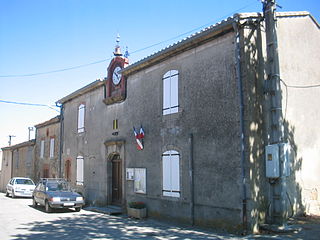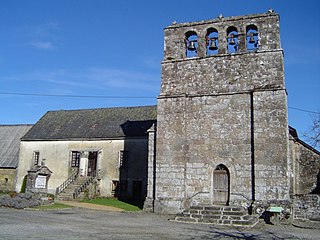
São Jorge is an island in the central group of the Azores archipelago and part of the autonomous region of Portugal. Separated from its nearest neighbours by the 15-kilometre (9.3 mi) Pico-São Jorge Channel, the central group is often referred colloquially as part of the Triângulo ("Triangle") group or just "The Triangle". São Jorge is a relatively long thin island with tall cliffs, whose 8,381 inhabitants are concentrated on various geological debris fields (fajãs) along the north and south coasts; from east to west, the island is 53 kilometres (33 mi) long and, north to south, 8 kilometres (5.0 mi) wide: its area is 237.59 square kilometres (91.73 sq mi).

Lajes das Flores is a municipality in the western part of the Azores; it includes the southern part of the island of Flores. To the north, where it is bordered by Santa Cruz das Flores. The population in 2021 was 1,408, in an area of 70.05 square kilometres (27.05 sq mi). Its municipal seat is in the parish of the same name.

Fajã Grande is a rural civil parish in the municipality of Lajes das Flores in the Portuguese archipelago of the Azores. The population in 2021 was 220, in an area of 12.97 km2. Although it is a relatively small population, it is one of the largest centers in the municipality of Lajes das Flores, about 17 kilometres (11 mi) from the municipal seat, and the westernmost settlement in Europe. It contains the localities Cuada, Ponta and Fajã.

Fajã de Cima is a civil parish in the municipality of Ponta Delgada in the Portuguese archipelago of the Azores. Fajã de Cima is located in the Picos region in the western part of the island of São Miguel, north of central Ponta Delgada. The population in 2011 was 3,438, in an area of 11.89 km².

Fajã is a Portuguese term of obscure origin used to describe supratidal talus at the foot of coastal cliffs, caused by landslides or lava flows. Although relatively common world-wide, they are distinctive features of the Azores and Madeira, as well as of the Canary Islands, where the equivalent term in Canarian Spanish is fajana. The term also designates a small flat piece of land, generally cultivable and located by the sea, formed of materials fallen from cliffs. Another Canarian word for lava fajanas is isla baja, literally, "low island".
SS Faja de Oro was an oil tanker built in 1914. She sailed for a number of companies, and survived service in the First World War, only to be torpedoed and sunk by a German submarine during the Second World War while sailing under the Mexican flag in the Gulf of Mexico. Her sinking contributed to Mexico's decision to enter the war on the side of the Allies.
La Fage-Montivernoux is a commune in the Lozère department in southern France.
Saint-Pierre-de-la-Fage is a commune in the Hérault department in the Occitanie region in southern France.

Lafage is a commune in the Aude department in southern France.

Lafage-sur-Sombre is a commune in the Corrèze department in central France.

Drémil-Lafage is a commune in the Haute-Garonne department in southwestern France. It is located 13 km east from Toulouse.
The Fajã Amaro da Cunha is a permanent debris field, built from the collapsing cliffs on the northern coast of the civil parish of Rosais, in the municipality of Velas, island of São Jorge, in the Portuguese archipelago of the Azores.

Martanesh is a geographic and ethnographic region within the Dibër County in eastern Albania. Formerly a commune, at the 2015 local government reform it became a subdivision of the municipality Bulqizë. The population at the 2011 census was 1,836. The settlement holding the status of town is Krastë, which was also the center of the commune. The population is largely Bektashi with a rather small Catholic minority, and the commune contains the Teqe of Martanesh.
The Fajã do Pedregalo, is a permanent debris field, built from the collapsing cliffs on the northern coast of the civil parish of Rosais, in the municipality of Velas, island of São Jorge, in the Portuguese archipelago of the Azores.

The 10th annual Berlin International Film Festival was held from 24 June to 5 July 1960. The Golden Bear was awarded to the Spanish film El Lazarillo de Tormes directed by César Fernández Ardavín.

The Fajã dos Tijolos is a permanent debris field, built from the collapsing cliffs on the northern coast of the civil parish of Ribeira Seca, in the municipality of Calheta, island of São Jorge, in the Portuguese archipelago of the Azores.

Lagoa da Fajã dos Cubres is a lagoon located in the parish of Ribeira Seca, on the north coast of the Portuguese island of São Jorge. The lagoon was listed along with Lagoa da Caldeira as a "Wetland of International Importance" under the Ramsar Convention in 2005. The term fajã refers to the plain areas created from landslides of the abrupt coastal cliffs.

Lagoa da Fajã de Santo Cristo is a lagoon located on the north coast of the Portuguese island of São Jorge. The lagoon was listed along with Lagoa da Fajã dos Cubres as a "Wetland of International Importance" under the Ramsar Convention in 2005. The fajãs and coastal area connecting the two lagoons make up the remainder of the wetland.
The Fajã de Além is a permanent debris field, known as a fajã, built from the collapsing cliffs on the northern coast of the civil parish of Norte Grande, in the municipality of Velas, island of São Jorge, in the Portuguese archipelago of the Azores.













